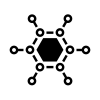The market for quantum dots is growing at a high pace with the main driver being display technologies. The leading technology company Nanosys Inc., which produces quantum dot coated films, is heavily benefitted by this and helps drive the innovation of new products.
Content
- Short facts
- Products and customers
- Comparison with other technologies
- New market opportunities
- Challenges
- Outlook
Short facts[i],[ii]:
- Status: Private
- CEO: Jason Hartlove
- Investors: 32
- Latest investment round: USD 20M
- No. of employees (approximately): 120
- Location: Silicon Valley
Products and customers
The main products that Nanosys produces are plastic films coated by quantum dots of green and red colors that are then used by other manufactures in displays[iii]. In 2019, Nanosys’ nanotechnology had been featured in more than 400 different products with more than 30,000 kg of quantum dot material having been shipped.
They are often integrated into LCD displays that use a blue LED backlight together with the quantum dots to produce RGB displays that are energy efficient and have extremely bright colors. The newest generations of quantum dot films are completely heavy metal free and are mainly made of Indium phosphide (InP)[iv].
Their main customer and biggest investor is Samsung. Other customers using Nanosys quantum dots in their products include Vizio, HP, Hisense, and TCL. They are collaborating with MIT, Lawrence Berkeley National Labs, Hebrew University, Philips-Lumileds, and more which is part of the reasons for their high achievements.
Comparison with other technologies
A technology that often gets compared with QLED (Quantum LED) displays is OLEDs (Organic LEDs). The two technologies are often competing with the best OLED TV displays being produced by LG.
While QLEDs are brighter and often more energy-efficient, OLEDs can produce better contrast and much thinner displays, which is something LG is particularly good at. Both technologies have multiple other pros and cons which can be a long discussion. However, what has of late become interesting is the possibility of combining the best of both worlds with Samsung investing in a new hybrid quantum dot-OLED technology that they hope to start mass-producing in 2021[v].
To complicate matters even further, a third promising technology, MicroLED is challenging both QLEDs and OLEDs by offering similar advantages of brightness, contrast, and energy efficiency. This technology is showcased in Samsung’s The Wall[vi]. Nanosys has, however, incorporated this technology into its roadmap and believes that quantum dots can play a part in improving microLED displays[vii].
What might be an outcome of these different technologies is a mixture of Quantum dot-OLEDs and microLEDs with quantum dots in the long run.
New Market opportunities
While the applications within display electronics seem to continuously grow, there are other opportunities awaiting quantum dots and Nanosys.
The CEO of Nanosys acknowledges solar cells as a future opportunity as quantum dots have much better theoretical efficiencies compared to current silicon-based ones. In addition, he mentions smart windows (incorporating solar cells in glass, in this case with quantum dots) as a research area and possible future application.
Challenges
Some main challenges that have already been addressed are the ‘scalability’ which Nanosys seems to have solved, now using 1250 L reactors compared to 5 L ones in 2013. Others have been the price, which now has been brought down, making a QLED TV a much more mainstream product, and finally that cadmium and other heavy metals used for quantum dots are often toxic. However, this should no longer be an issue as Nanosys produce heavy metal-free ones already [iii].
While there are other companies working with quantum dots, Nanosys has close to 100 % market share[viii]. It therefore seems to be that current challenges mainly come from competing technologies, which could however in future scenarios be combined with quantum dots.
A good strategy that Nanosys seems to employ in its roadmap is trying to facilitate these combined technologies and being open to what OLEDs and microLEDs have to offer while still utilizing their expertise in quantum dots.
Outlook
With the prediction from MarketsandMarkets of an increase in the quantum dot market size from USD 3.5 billion in 2020 to USD 10.6 billion by 2025[ix] (annual growth: 24.6 %) and backing from large investors, Nanosys should be well off by continuously producing quantum dots at large scale. They need to keep collaborating with their partners in the industry and at universities to improve the application in displays. It is also going to be interesting to see how they might play a role in improving solar cells and create smart windows.
If you’d like to learn more about quantum dots and other nanotechnologies, please subscribe to our newsletter and stay tuned for upcoming posts.
[i] Nanosys overview, accesed at https://pitchbook.com/profiles/company/50754-52#competitors
[ii] Nanosys company profile, accesed at https://www.crunchbase.com/organization/nanosys?utm_source=linkedin&utm_medium=referral&utm_campaign=linkedin_companies&utm_content=profile_cta
[iii] Nanosys Products, accesed at https://www.nanosysinc.com/products
[iv] CEO keynote speech, 2019, accessed at: https://www.youtube.com/watch?v=74W4MRwe4d0
[v] Samsung OLED quantum dot hybrid could challenge LG for TV supremacy, Aug 2020, accessed at https://www.cnet.com/news/samsung-oled-quantum-dot-hybrid-could-challenge-lg-for-tv-supremacy/
[vi] Samsung’s The Wall, accesed at https://www.samsung.com/us/business/products/displays/direct-view-led/the-wall/
[vii] Nanosys Roadmap, accesed at https://www.nanosysinc.com/nanosys-roadmap
[viii] Nanosys Quantum Dots, CEO Jason Hartlove Interview, accesed at https://www.youtube.com/watch?v=6oERnxm4-ko

